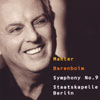Mahler Symphony No 9
Barenboim finds the terror and dread in Mahler’s haunted work
View record and artist detailsRecord and Artist Details
Composer or Director: Gustav Mahler
Genre:
Orchestral
Label: Warner Classics
Magazine Review Date: 6/2007
Media Format: CD or Download
Media Runtime: 78
Mastering:
Stereo
DDD
Catalogue Number: 2564 64316-2

Tracks:
| Composition | Artist Credit |
|---|---|
| Symphony No. 9 |
Gustav Mahler, Composer
Berlin Staatskapelle Daniel Barenboim, Conductor Gustav Mahler, Composer |
Author: Andrew Farach-Colton
Alban Berg described the first movement of Mahler’s Ninth Symphony as “permeated by the premonition of death”. In this cleanly recorded live performance from Berlin, death’s unnerving presence is keenly felt. Barenboim’s propulsive tempi generate a feeling of breathless terror and the sense of dread is palpable in still passages as well – note, for example, how tentatively the conductor feels his way through the eerily desolate landscape beginning at 13'45". The Ländler-like second movement is also vividly characterised, with sharply pointed rhythms, cheeky woodwinds and some memorably gutsy horn playing. If only the Rondo-Burleske had a little more thrust; the Berlin Staatskapelle’s playing is appropriately tenacious and gritty but the result is not nearly desperate enough. Then again, only Karajan (in his live 1982 recording for DG) comes close to matching the panicked tumult of Bruno Walter’s pioneering 1938 account from Vienna (EMI).
The performance comes back into focus in the finale. Barenboim keeps the tempo flowing forward and uses accents (marked in the score) to inject a hint of roughness to the otherwise lush string writing. He also draws a sharp distinction between the full-throated passion of the primary thematic material and the ghostly pallour of the passages marked ohne Ausdruck (without expression). Indeed, in the pages leading up to the cymbal-capped climax (14'13"), as well as in those that follow, the music moves in grand, ecstatic waves – a kind of Mahlerian “love-death”. The final bars are whispered, cool and calm. On the whole, an absorbing, often gripping interpretation.
The performance comes back into focus in the finale. Barenboim keeps the tempo flowing forward and uses accents (marked in the score) to inject a hint of roughness to the otherwise lush string writing. He also draws a sharp distinction between the full-throated passion of the primary thematic material and the ghostly pallour of the passages marked ohne Ausdruck (without expression). Indeed, in the pages leading up to the cymbal-capped climax (14'13"), as well as in those that follow, the music moves in grand, ecstatic waves – a kind of Mahlerian “love-death”. The final bars are whispered, cool and calm. On the whole, an absorbing, often gripping interpretation.
Discover the world's largest classical music catalogue with Presto Music.

Gramophone Digital Club
- Digital Edition
- Digital Archive
- Reviews Database
- Full website access
From £8.75 / month
Subscribe
Gramophone Full Club
- Print Edition
- Digital Edition
- Digital Archive
- Reviews Database
- Full website access
From £11.00 / month
Subscribe
If you are a library, university or other organisation that would be interested in an institutional subscription to Gramophone please click here for further information.




